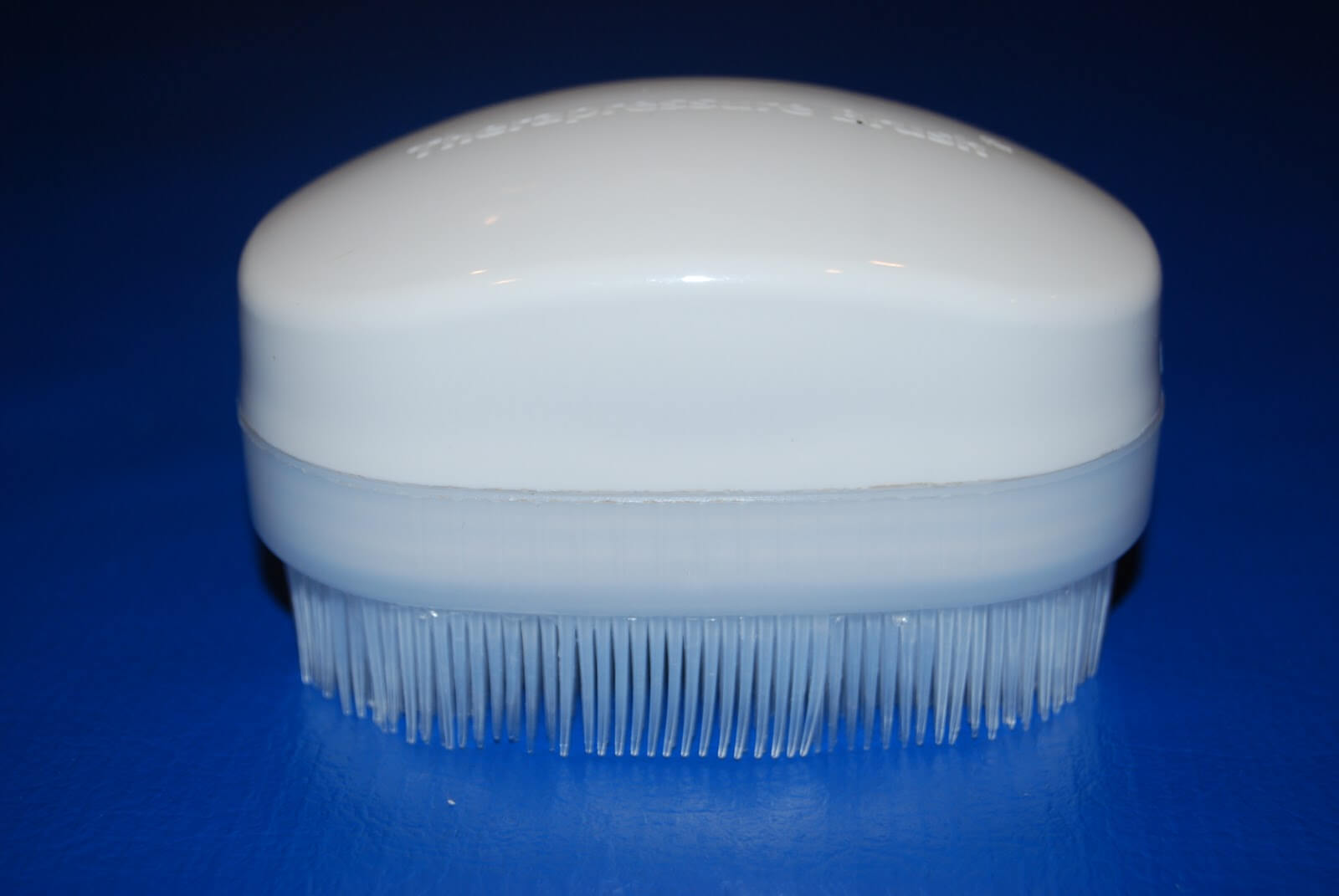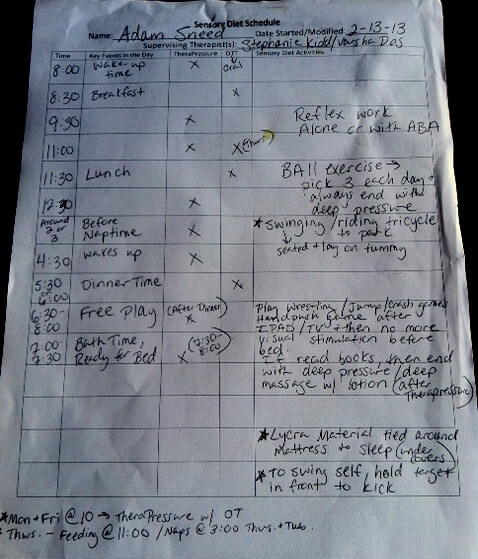A Sensory Diet
Note: I may earn money or products from the companies, products, or links mentioned in this post.
Today is a very important day for our family as today is the first day of our son, Adam’s sensory diet. We will be following the program set up by his OT for the next 6-8 weeks and are very hopeful that this is going to help a lot of his problems. We have been asked a lot of questions about sensory diets, what it is and what he will be doing, so I thought I would write a post explaining what it is and what we will be doing.

What is a Sensory Diet?
“Just as your child needs food throughout the course of the day, his need for sensory input must also be met. A ‘sensory diet’ (coined by OT Patricia Wilbarger) is a carefully designed, personalized activity plan that provides the sensory input a person needs to stay focused and organized throughout the day. Just as you may jiggle your knee or chew gum to stay awake or soak in a hot tub to unwind, children need to engage in stabilizing, focusing activities too. Infants, young children, teens, and adults with mild to severe sensory issues can all benefit from a personalized sensory diet.
The great news is that the effects of a sensory diet are usually immediate AND cumulative. Activities that perk up your child or calm him down are not only effective in the moment; they actually help to restructure your child’s nervous system over time so that he is better able to:
- Tolerate sensations and situations he finds challenging.
- Regulate his alertness and increase attention span.
- Limit sensory seeking and sensory avoiding behaviors.
- Handle transitions with less stress.”
Read more here… Sensory Diet.

Last week we met with Adam’s OT and got a written plan of the sensory diet we are going to be doing with Adam. I also got trained on how to to do therapeutic brushing, compression joints, and oral tactile technique – these I will explain below.
Therapeutic Brushing (Wilbarger Protocal)
“The Therapressure Brush is a must-have tool for treating sensory integration issues in children and adults. The Wilbarger Deep Pressure and Proprioceptive Technique is a therapy program designed to reduce sensory or tactile defensiveness. Children who exhibit symptoms of tactile defensiveness are extremely sensitive to touch. This can cause a fear or resistance to being touched, difficulty transitioning between activities, and/or lethargy.
Many parents of children with autism have reported seeing decreases in sensory defensiveness and anxiety as a result of using this technique. Some of the benefits of the Wilbarger Protocol may include improved ability to transition between daily activities, improved attention span, a decreased fear or discomfort of being touched, enhanced coordination, and self-regulation.” – especialneeds.com
Joint Compressions
“After the brushing therapy, therapists may also prescribe gentle joint compressions to the shoulders, elbows, wrists, fingers, hips, knees/ankles, and sternum for a count of ten. Joint compressions are a good exercise for children with sensory issues who are out of touch with their physical sense of self and need to regain their body awareness.
By pushing down numerous times (gently!) on the child’s joints on each part of his body, the child relearns the positions of and the sense of his limbs and head. It is also very calming for the child. Parents learn to use this joint compression technique before bringing their child to a place or an event that may be crowded and noisy, or require the child’s best behavior. Providing this proprioceptive sense for the child will help him manage his reactions to the over stimulation and assist him in controlling his compulsive behaviors.”
– natationalautismresources.com & sensoryandmore.com
Here is a video of the therapist training me on the Wilbarger brushing and joint compressions. This video was taken after she taught me how to do it and showed me by doing the brushing and joint compressions on me.
Oral Tactile Technique
“The therapist may also suggest the Oral Tactile Technique, or OTT. This technique requires a finger to swipe along the inside of the person’s mouth. This is helpful for kids with oral defensiveness. (These children may have trouble with foods because of their texture or hate having their teeth brushed).” – thenationalautismresources.com
For Adam we will be swiping the inside of his mouth (the roof of his mouth) three times and then pressing down on his lower set of teeth twice. We will be doing this three times a day (before every meal).
The Sensory Diet
Like I said before last week I sat down with Adam’s OT and we went over the best way to do this – especially with the crazy schedule that we already have with all his other therapies. I think we figured out a good way to do all this, but it’s still a lot. Here is the plan the OT wrote out for us:
The program is 6-8 weeks long and everything on the sheet above we will be doing every single day. The OT has really high hopes of this helping Adam so I am determined to somehow fit this into our busy schedule. Somehow I will do it.
The brushing has to be done every 1-2 hours while he is awake. The OT has us down for every hour and a half. The joint compressions need to be done every single time as well right after the brushing. This comes to doing brushing and joint compressions about 8 times a day give or take a few. We also will be doing the OTT with his mouth 3 times a day as mentioned above.
They say once we complete this program he should be good to go on this stuff at least for awhile. They said sometimes when the kids hit puberty things change and they may have to do the brushing program again, but for now this will be it, and for me that’s enough.
On top of the brushing, joint compressions and OTT they also want us to get in other “exercises” into his sensory diet every day. These things include reflex work, vestibular activities, proprioceptive activities, oral motor activities and tactile activities (you can see examples of those things here: Sensory Diet Activities). As you can see from the chart above, for Adam these things include things like: ball exercises, deep pressure, swinging, play wrestling, jumping and crashing games and more.
I would be lying if I said I wasn’t nervous and stressed about this. Nervous because I want to do this right and I want this to help him so bad, and stressed because this is adding a TON onto my already very busy and complicated schedule. We will still have therapy 9-10 times a week plus regular activities and appointments.
I know anything is possible through Christ who gives me strength, so I ask for you to pray for us during the next few months that we will get this added to our schedule smoothly and that Adam will take to it very well. Thank you so much for reading and I hope that if you have any questions you will feel free to just ask!







Wow praying for you all and that it goes well!
Good luck! When we did the brushing and what my son called “pushes”(the compressions), I set an alarm on my phone for the next time we needed to do it. That helped keep us on track.
Kathryn, you & Jon are amazing! So many parents would have already given up! Praying for you & Adam as you incorporate these things into your lives.
Oh Kathryn! That is so much… I will definitely be praying for you and Adam in all of this.
Wow. It all sounds so overwhelming. I wish I had words of encouragement or could do something to help. I will definitely be praying for grace and strength for you!
I just started a brushing protocol w/my daughter. (We are literally using the EXACT same worksheet you have!)
So, how has it worked for you? Did you see improvement with the brushing?
Thanks for your time!
a
Hi Amanda! Been a fan of your blog for awhile, so happy to see your face here! We did the brushing program almost two full years ago, but it was good for my son. It’s very hard to keep on the schedule and to do everything exactly as prescribed, but if/when you do it does work. We did it for the amount of time and still do some sensory diet activities minus the brushing now, and overall the change has been tremendous. My son is a completely different person, still has a lot of sensory issues, but he has worked through so much. The brushing program is good, but I think the biggest part is the other activities. The brushing did help some, but it was hard to tell how much it really worked. I think overall everything together is a great process. I hope this makes sense! Looking back I wouldn’t change a thing and I am glad we did it. We also have a sensory rom for my son now: (some tips for you: https://singingthroughtherain.net/2014/09/sensory-room.html) and that helps A LOT. Good luck, I hope that looking back that you see a huge improvement from now to then like we did!